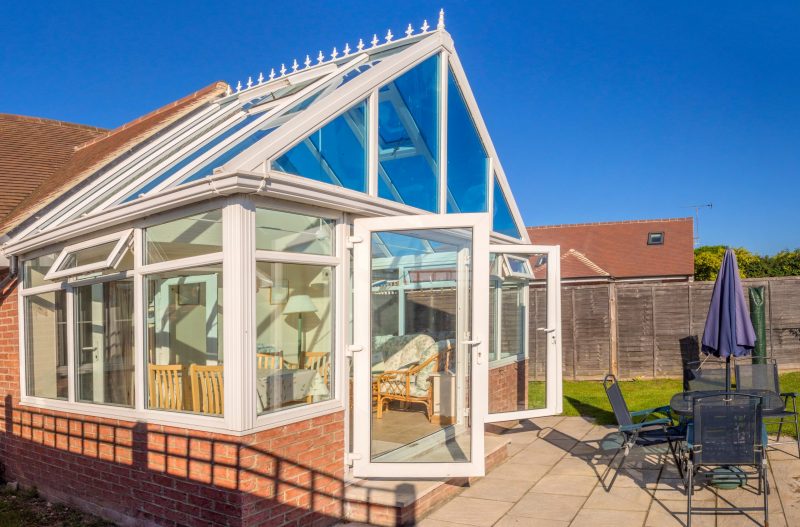Ever feel like your once-beloved conservatory has turned into a glass oven in summer and an icebox in winter? You’re not alone, and you don’t have to demolish it to reclaim the space.
By exploring conservatory roof conversions, you’ll discover how a simple structural tweak can moderate temperatures, dampen noise, and let the room finally blend with the rest of your home’s personality without spiralling costs or major construction work.
Defining Roof Conversion
A conservatory roof conversion replaces lightweight glazing with an insulated, solid structure, dramatically improving comfort, efficiency, and aesthetics without rebuilding the walls or foundations you already love.
- Polycarbonate swap-out. Replace noisy, heat-leaking polycarbonate sheets with lightweight insulated panels that slot straight onto your existing frame without heavy structural work.
- Glass to hybrid. Trade single-skin glass for argon-filled, solar-control glazing mixed with insulated sections to keep the light while taming temperature swings.
- Full tiled upgrade. Fit breathable membranes, timber rafters, and lightweight slate-effect tiles so the space finally feels like a true extension of your home.
- Interior finishes. Add plasterboard, spotlights, and optional roof windows to create a room that looks and feels identical to the rest of the house.
By understanding these four core approaches, you can quickly decide which system meets your budget, local climate, and design aspirations without getting lost in technical jargon.
Year-Round Living Comfort
Once the roof is properly insulated, the conservatory stops acting like a greenhouse and starts behaving like a genuine room, welcoming you at any hour, season, or weather.
Beating winter chills
Multi-layer insulation, breathable membranes, and properly sealed ridge details trap warm air, so you no longer dread stepping onto icy floors with a cup of coffee at dawn.
Cooling sticky summers
Low-emissivity coatings bounce solar gain back outside, while discreet roof vents release hot air, making August afternoons comfortable enough for remote work or a family brunch.
Cutting annoying noise
Rainfall that once sounded like a drum solo now becomes a muted backdrop, thanks to dense insulation and tile surfaces that absorb and dampen exterior clatter effectively.
Energy Savings & Efficiency
Upgrading the roof dramatically reduces heat loss, meaning radiators work less, air-conditioning becomes unnecessary, and your monthly energy statement suddenly looks refreshingly smaller.
- Lower U-values. Modern roofing systems routinely achieve 0.15 W/m²K, outperforming many traditional cavity walls and slicing your heating demand during frosty evenings.
- Solar control glass. High-performance coatings filter ultraviolet rays while letting visible light flood in, cutting glare and preventing soft furnishings from fading prematurely.
- Integrated LED lighting. Low-energy downlights wired into new plastered ceilings replace temporary lamps, keeping electricity consumption minimal while boosting ambience.
- Real-world savings. Homeowners report up to 25 percent reductions on annual bills after conversion, according to independent surveys quoted by energy-focused installers.
Combine these measures and the conservatory shifts from financial drain to energy asset, often improving your property’s overall EPC rating in the process.
Thermal And Acoustic Gains
Your senses immediately notice the difference: temperatures stabilise, echoes disappear, and the conservatory finally feels like the coziest, quietest corner of the house.
Insulation thickness matters
Lightweight structural insulated panels sandwich rigid foam up to 125 mm thick, forming a continuous thermal envelope that outperforms old glass by several magnitudes.
Multi-layer vapour control
Breathable membranes let moisture escape while blocking drafts, stopping condensation before it forms and protecting furniture, fabrics, and electronics from damp damage.
Sound-deadening layers
Dense plasterboard, acoustic mineral wool, and composite tiles reduce external noise by up to 30 dB, making heavy rain sound like a distant whisper instead of chaos.
Aesthetic Refresh Inside Out
Beyond pure performance, a new roof delivers an instant style makeover, helping the conservatory blend seamlessly with both exterior brickwork and interior décor.
Exterior harmony
Choose slate-effect, shingle, or clay-look tiles to mirror your main roof, creating a unified silhouette that boosts curb appeal and satisfies planning officers.
Interior elegance
Plastered vaulted ceilings with subtle spotlights replace unsightly glazing bars, giving you the design freedom to paint, decorate, and furnish like any other lounge.
Optional rooflights
Contemporary flat-glass skylights or heritage-style lanterns inject drama, offering framed sky views without the thermal penalty typical of full-glass roofs.
Boosting Home Value
Estate agents often highlight a converted conservatory as a premium selling point, because buyers love extra, comfortable square footage that’s genuinely usable every day.
- Perceived floor space. A room that’s warm, bright, and stylish feels like a true extension, nudging your property into the next price bracket.
- Improved EPC ratings. Better insulation translates into lower running costs, an increasingly important consideration for eco-conscious purchasers.
- Curb-appeal upgrade. Matching tiles and sleek guttering create a cohesive exterior image that photographs beautifully for online listings and print brochures.
- Future-proof investment. Quality systems carry 40-year life expectancies and transferable warranties, giving potential buyers long-term peace of mind.
While local markets vary, surveyors regularly factor these advantages into higher valuations, especially when documentation and guarantees are neatly filed for inspection.
Key Planning Considerations
Before any tiles are lifted, spend time on due diligence; getting the paperwork, structural checks, and design details right prevents expensive revisions later on.
Building regulations
Switching from translucent to solid roofing typically triggers energy and structural requirements; your installer should handle the application and supply compliance certificates.
Structural integrity
An engineer may specify reinforcement for older PVC frames; lightweight tile systems minimize extra load, though calculations are still essential for safety and insurance.
Daylight balance
Solid roofs reduce overhead light, so plan skylights or wider openings between conservatory and house to maintain a bright, airy atmosphere throughout adjoining rooms.
Materials And Design Choices
The right material mix balances looks, performance, and budget, letting you tailor the finish so it feels custom-built rather than a one-size-fits-all solution.
Polycarbonate alternatives
Modern multi-wall sheets now include UV filters and honeycomb insulation, but most homeowners still move towards higher-performing options for maximum comfort.
High-tech glazing
Self-clean coatings and argon-filled cavities deliver impressive U-values while preserving garden views, ideal when light is top priority and overheating is managed.
Lightweight slate tiles
Engineered composites recreate the texture of natural stone at a fraction of the weight, often approved under LABC-certified systems for hassle-free compliance.
Selecting Skilled Installers
A brilliant roof system installed poorly performs no better than a cheap alternative, so vetting your contractor is every bit as critical as choosing materials.
- Check accreditations. Look for LABC, TrustMark, or CPA membership; these bodies audit quality and provide insurance-backed guarantees against future defects.
- Read real reviews. Balance glowing testimonials with independent feedback on social platforms; note how the company handles occasional negative comments.
- Demand specialist focus. Firms that convert roofs daily bring refined processes, accurate timelines, and fewer on-site surprises than general builders.
- Verify paperwork. A reputable installer will outline costs, schedules, and warranty terms in writing.
Choosing wisely ensures the project finishes on time, on budget, and with certification that keeps surveyors, insurers, and future buyers entirely satisfied.
Maintenance For Longevity
After installation, upkeep is minimal yet important: inspect gutters, clear debris, and replace damaged tiles promptly to protect insulation layers and structural timbers beneath.
An annual wash of external surfaces, quick sealant check, and occasional skylight cleaning preserve appearance and guarantee that thermal performance stays high for decades.
Final Takeaways
Evaluate why you built the conservatory, how you live now, and what performance gaps remain. A well-planned roof conversion tackles heat loss, glare, noise, and aesthetics in one decisive move.
Assess regulations, budgets, installers, and upkeep early, then proceed methodically. The result is purposeful space, not merely improved shelter indoors.


